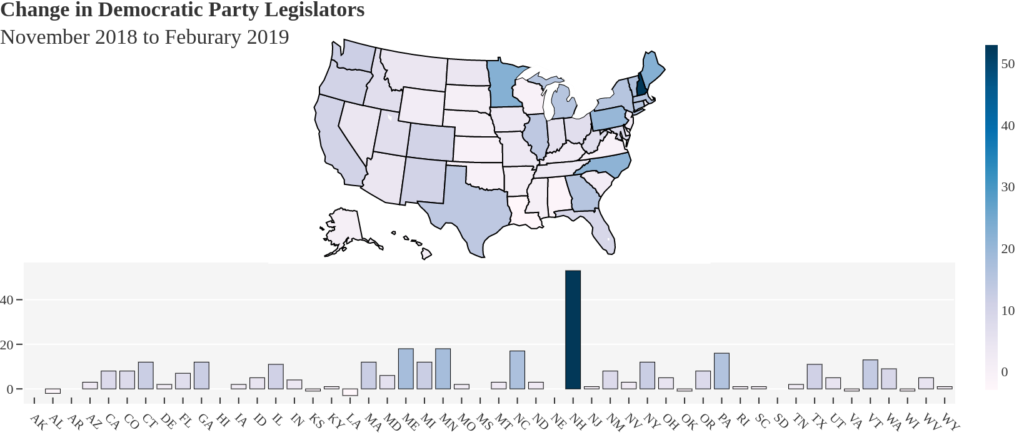Here’s a map of every state legislator in the U.S. as of February 2019, with districts and elected official data from the Cicero database. Knowing that space doesn’t necessarily equal people, we decided to first visualize with dots indicating the center point of each legislative district. However, we wanted users to have the option to view the actual geography of legislative districts, so we added a toggle between the two on the map.
Click here to view full-screen interactive version.
Was the 2018 election a Democratic wave?
Overall, Democrats gained 311 seats while Republicans lost 257 seats. Coming into the election, Republicans had 4,076 state legislators compared to Democrats with 3,137. As of February 2019, after the general election, special elections, and many vacant seats being filled, Republicans now have 3,819 and Democrats have 3,448. There are gaps in those two sets of numbers because of previously vacant seats that were filled with new legislators.
Out of states that had legislative elections in 2018, Democrats had a net gain of seats in 35 states, compared to 9 states for Republicans. Leading the charge was New Hampshire, with a gain of 53 seats for Democrats between its massive House of Representatives (400 seats!) and State Senate. Democrats won 18 more seats in Maine’s legislature, while they picked up 17 seats each in Minnesota and Pennsylvania. A few states saw a shift towards Republicans, continuing trends in those states that have been ongoing for the past few election cycles. For example, Republicans gained a net of 5 seats in Alabama and Missouri. Minnesota and New Hampshire now have more elected Democrats in their state legislatures than Republicans, and six state legislative chambers switched from Republican to Democratic control:
- Colorado State Senate
- Maine State Senate
- Minnesota House of Representatives
- New Hampshire House of Representatives and State Senate
- New York State Senate

Fewer Republicans, but also fewer third party members
Third parties and independents have historically struggled to gain ground in U.S. legislatures. Despite more Americans identifying as independent, many do not vote for third parties or Independent candidates. Overall, independents and third parties lost 7 seats in the last election. Vermont’s legislature has more elected third parties than any other state, with the Progressive Party’s 8 seats in the House and Senate, which is down one member compared to last year. Vermont also has the most independents, with 5 legislators, followed by Maine with 4 independents in its House of Representatives.
Want more data? Check out our Cicero Elected Officials and Districts tool to enter your address and see more information about the people that represent you.
